PerfectPath Technlogies Total Contact
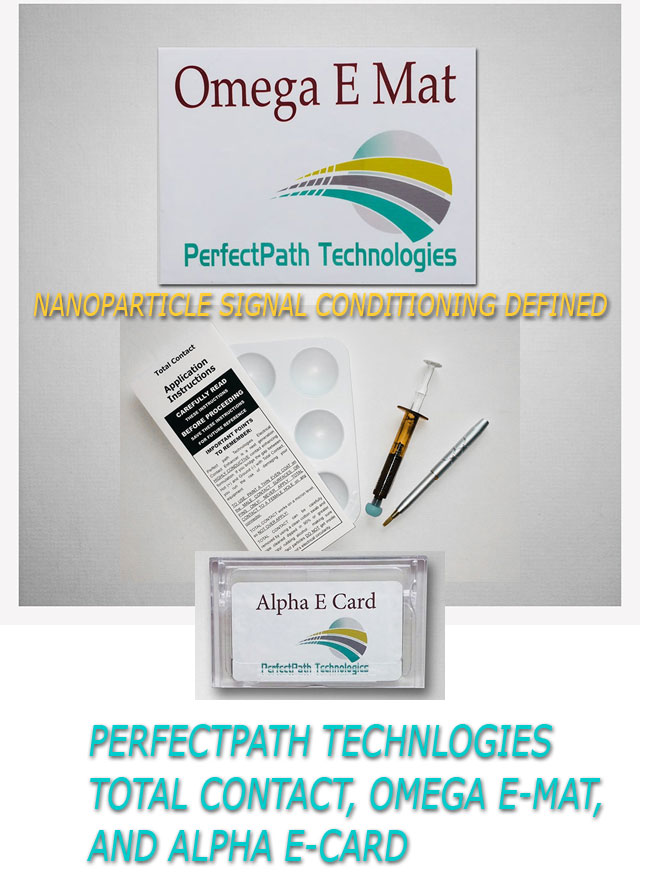
 You never know what you’ll find browsing the Tweak section of Audiogon. One can find the latest version of a company’s tweaky product there. I can still remember seeing the advertisement for Total Contact Enhancer (TC) for the first time on a cold weekend morning back in February and thinking, “Wow, another contact enhancement product, but this product is $300.00 – 3x more than I spent on the last contact enhancement (which degraded in performance over time)”. I later read through the product review and responses listed in the Audiogon Forum that was referenced in the enclosed link contained within the advertisement. The Audiogon Forum response on this contact enhancer seemed different. What started as a small thread became one of the largest threads with the most views on Audiogon. The positive response from early users pique’d my interest until I finally purchased my first syringe of TC. Since the initial TC product launch, PerfectPath Technologies has developed follow on products such as the Omega e-mat, and Alpha e-card which are marketed as power conditioners designed to enhance the electrical conductivity of internal circuitry of your music components while protecting it from static and EMI/RFI energy fields.
You never know what you’ll find browsing the Tweak section of Audiogon. One can find the latest version of a company’s tweaky product there. I can still remember seeing the advertisement for Total Contact Enhancer (TC) for the first time on a cold weekend morning back in February and thinking, “Wow, another contact enhancement product, but this product is $300.00 – 3x more than I spent on the last contact enhancement (which degraded in performance over time)”. I later read through the product review and responses listed in the Audiogon Forum that was referenced in the enclosed link contained within the advertisement. The Audiogon Forum response on this contact enhancer seemed different. What started as a small thread became one of the largest threads with the most views on Audiogon. The positive response from early users pique’d my interest until I finally purchased my first syringe of TC. Since the initial TC product launch, PerfectPath Technologies has developed follow on products such as the Omega e-mat, and Alpha e-card which are marketed as power conditioners designed to enhance the electrical conductivity of internal circuitry of your music components while protecting it from static and EMI/RFI energy fields.
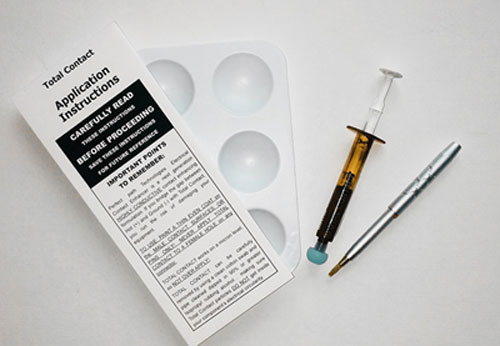
Total Contact Enhancer
According to the PerfectPath Technologies website, “Total Contact Enhancer is the world’s most advanced and powerful hybrid Graphene & next generation of super contact enhancement. It was specially designed to increase and preserve the conductivity of metals. TC stops oxidation indefinitely; forming a tough polymer shell that is easily reversible, even after full polymerization. It creates a highly conductive bond between 2 surfaces without over time degradation”. The kit includes 1.5 ml of Total Contact paste packaged in a 10cc syringe, a small plastic six well pallet to aid in the application of the paste, retractable aluminum brush for paste application, one pair non-latex gloves, and a set of instructions. It is recommended that the surfaces of contacts are cleaned prior to the application of a thin uniform coating and to expect a linear break-in period lasting up to 8 weeks.
I treated my reviewing system in steps. First, I applied TC to the contacts of my Tidal Audio Impact amplifier and connecting audio cables (chassis IEC connector, AC cord IEC pins, male ends of the XLR interconnects, male and female ends of the RCA grounding cable, and spades of the speaker cables). After allowing my system to stabilize for twelve hours, I listened for changes. With just treating ¼ of my system, it was easy to hear the improvement in bass response definition and soundstage imaging. Next, I treated all of the contacts on my digital front end consisting of the Ayon Audio S-5 Network Player/DAC/Preamp, QNAP NAS drive, and Uptone Audio JS-2. The benefits I heard in the first treatment of TC are magnified following the second treatment of TC. The bass became more detailed and the soundstage was expanded further. The resolution and transparency of my system was improved in ways not achieved by previous contact enhancement products. I was amazed at the detail revealed with the application of TC on my system’s contacts. Looking back at my notes I concluded that “This sounds like an entirely different system and TC is exactly what my system needs to sound it’s best”. In many ways, TC became the link that brought my highly tweaked reviewing system together.
Later, I treated my home theatre system which consists of a 65” OLED 4K HDTV, Oppo 4K blu-ray player, TiVo, Focal Dimension Soundbar and Subwoofer, and BPT Pure Power Center outlet strip. The TC treatment included painting the gold plated HDMI connector shells, IEC connectors, and ac power cord connectors. I definitely saw greater color saturation and a brighter and a more resolving picture on the OLED. The improved 4K HD picture required recalibration of the brightness and contrast, leading to reduction in output. The sound track of movies became more enjoyable through the Focal Dimension Soundbar and Subwoofer following the addition of TC with the improvements paralleling what was experienced in my two channel reviewing system.
 Based on initial reports in the PerfectPath TC forum thread, I pasted all of the contacts in my AC electrical panel and the AC mains within my utility meter with a licensed electrician present. This was a few weeks prior to attending the AXPONA show this year. At that time, I had discovered the jazzy blues album, “Everybody Has a Plan Until They Get Punched in the Mouth” [GroundUP Music] by Charlie Hunter. On this recording, Charlie Hunter leads a quartet featuring three highly individualistic players-drummer Bobby Previte and trombonist Curtis Fowlkes, both of whom have collaborated with Hunter previously, and newcomer Kirk Knuffke on cornet. With my entire system, including the AC electrical panel treated with TC, I heard greater bass impact, improved resolution of fine details, images better fleshed out, less signal compression, and a lower noise floor. The trumpet and trombone in each of the recordings had greater presence. Prior to the TC treatment, all instruments were muted in comparison. As a result, I became more drawn into the music which resulted in many extended listening sessions.
Based on initial reports in the PerfectPath TC forum thread, I pasted all of the contacts in my AC electrical panel and the AC mains within my utility meter with a licensed electrician present. This was a few weeks prior to attending the AXPONA show this year. At that time, I had discovered the jazzy blues album, “Everybody Has a Plan Until They Get Punched in the Mouth” [GroundUP Music] by Charlie Hunter. On this recording, Charlie Hunter leads a quartet featuring three highly individualistic players-drummer Bobby Previte and trombonist Curtis Fowlkes, both of whom have collaborated with Hunter previously, and newcomer Kirk Knuffke on cornet. With my entire system, including the AC electrical panel treated with TC, I heard greater bass impact, improved resolution of fine details, images better fleshed out, less signal compression, and a lower noise floor. The trumpet and trombone in each of the recordings had greater presence. Prior to the TC treatment, all instruments were muted in comparison. As a result, I became more drawn into the music which resulted in many extended listening sessions.
Four weeks after my “AC panel service” was completed, I hosted a local audiophile friend, who is highly discerning when it comes to music reproduction and system set-up and hadn’t heard my system since applying TC. The friend has grown quite familiar with my system over the last few years. He listened to my system and immediately shook his head and said, “You’ve made a lot of changes since I was last here. What did you do to your system? You’ve always had a low noise floor but your system’s noise floor is much lower than I have ever heard and your system is better balanced and less forward sounding. The quality of the sound you’ve achieved is on par with what you would hear at one of the best set-up rooms at an audio show”.
 To determine that improvements provided by TC are not limited or system related, I swapped in my reference tube monoblock amplifiers for my reference solid state amplifier. In comparison, my reference tube monoblock amplifiers always had a muted transient response as compared to my reference solid state amp. The muted transient response of reference tube monoblocks amplifiers was partially addressed by replacing the stock fuses with SR Blue fuses and treating all contacts on the monoblocks with TC including the vacuum tube pins. Following full break-in of the TC, the last hint of transient response deficiency was gone and the transient response of my tube monoblocks were now on par with my reference solid state amplifier. With my tube monoblocks fully treated with TC, I heard much deeper into each recording with improved front to back layering and images of individual instruments were displayed with a higher density. It also was easy to hear individual piano notes and how the strings resonated within the sounding board when playing my favorite jazz recordings.
To determine that improvements provided by TC are not limited or system related, I swapped in my reference tube monoblock amplifiers for my reference solid state amplifier. In comparison, my reference tube monoblock amplifiers always had a muted transient response as compared to my reference solid state amp. The muted transient response of reference tube monoblocks amplifiers was partially addressed by replacing the stock fuses with SR Blue fuses and treating all contacts on the monoblocks with TC including the vacuum tube pins. Following full break-in of the TC, the last hint of transient response deficiency was gone and the transient response of my tube monoblocks were now on par with my reference solid state amplifier. With my tube monoblocks fully treated with TC, I heard much deeper into each recording with improved front to back layering and images of individual instruments were displayed with a higher density. It also was easy to hear individual piano notes and how the strings resonated within the sounding board when playing my favorite jazz recordings.
Eventually, I took the plunge and treated select components within the dual chassis of my network player/DAC/preamp to include the center sections of the R-core transformers, the center section of fuses, signal and dc power hook-up wire, tops of metal capacitors, entire outside surface of signal tubes, and the tops of DAC chips. Initially, my system sounded extremely warm but over the course of a few days it settled in and stereo images bloomed well beyond the front plane of my Tekton Double Impact SEs. Another application that significantly benefited my reviewing system was painting of the anode wire to the QB 5/1750 single output tube on my tube monoblock amplifiers. Other applications for TC includes painting the leads of axial leaded components on the speaker crossovers, AC outlet faceplate, and the loudspeaker binding post faceplate.
I’ve always wondered how well our delicate audio signals present in music reproduction are transmitted between compression fit contacts such as through audio cable RCA plugs and component RCA jacks without a loss of signal integrity. In the past, I’ve tried to address the signal loss and contact oxidation with the excellent products from Ciag Laboratories. Based on my experience with my entire system treated with TC, I’m convinced that TC greatly improves upon ordinary contact conditioners and cleaners. With each application of TC, the improved signal transmission across all frequencies was of such a high order that it led to further loudspeaker break-in.
One caveat to report related to TC: The break-in period does take time and during the first week the sound of my system tended to be warm and bass heavy following each application. If possible, it is recommended that the entire system be treated at once.
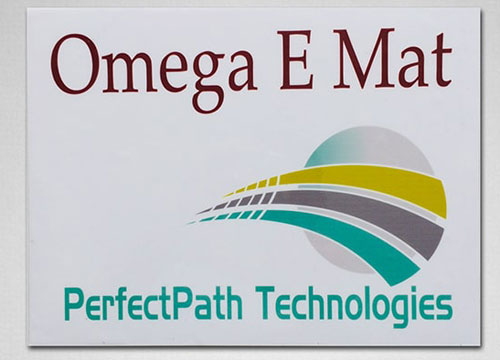
Omega e-mat and Alpha e-card
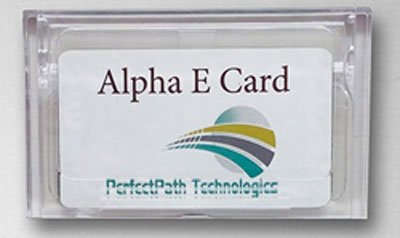 The OMEGA e-mat is a nanotechnology-based passive conditioner that measures 7.5” x 10”, slightly thicker than a refrigerator magnet. The Omega e-mat is designed with a magnetic side that allows attachment to any ferrous surface such as an AC panel door. It is recommended that once the e-mat is placed, it should be left undisturbed in order to sonically transform the treated component over time up to two weeks. The Alpha e-card is about 1/10 the size of the Omega e-mat and retails for 1/10 the cost of the Omega e-mat. Multiple e-mats and e-cards can be stacked vertically to multiply their performance which I will report on below.
The OMEGA e-mat is a nanotechnology-based passive conditioner that measures 7.5” x 10”, slightly thicker than a refrigerator magnet. The Omega e-mat is designed with a magnetic side that allows attachment to any ferrous surface such as an AC panel door. It is recommended that once the e-mat is placed, it should be left undisturbed in order to sonically transform the treated component over time up to two weeks. The Alpha e-card is about 1/10 the size of the Omega e-mat and retails for 1/10 the cost of the Omega e-mat. Multiple e-mats and e-cards can be stacked vertically to multiply their performance which I will report on below.
Having already treated my entire AC panel with TC (breakers, bus bar, utility main power input, and ground plane), Tim Mrock suggested I try his newly developed product, the Omega e-mat. Originally, the Omega e-mat was thought to be a compromise to painting the entire panel with TC, aiming to create a faraday gage. I started by installing two Omega e-mat mats on the inside of my 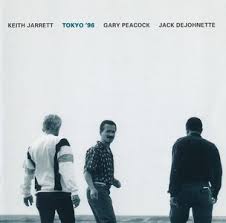 Cutler Hammer AC panel door. I can recall upon it vividly, how immediately impactful these were when I cued up the live album, “Tokyo 96” [EMC] by the Keith Jarrett. On the “Tokyo 96” album, the magic comes through in the strength of the mutual connections between Jarrett on the piano, Peacock on the bass, and DeJohnette on the drums in perfect balance. “By focusing on standards, with their familiar, formal blocks of four and eight measures and balanced harmonic progressions, Jarrett and friends open wide the windows on their inventions, making it easier to hear the way they extend the musical field of view, without significant creative restraint”. On each cut, Jarrett’s piano technique remains remarkable, with a subtle touch that supports liquid phrasing and a conception that reaches far out across bar lines and
Cutler Hammer AC panel door. I can recall upon it vividly, how immediately impactful these were when I cued up the live album, “Tokyo 96” [EMC] by the Keith Jarrett. On the “Tokyo 96” album, the magic comes through in the strength of the mutual connections between Jarrett on the piano, Peacock on the bass, and DeJohnette on the drums in perfect balance. “By focusing on standards, with their familiar, formal blocks of four and eight measures and balanced harmonic progressions, Jarrett and friends open wide the windows on their inventions, making it easier to hear the way they extend the musical field of view, without significant creative restraint”. On each cut, Jarrett’s piano technique remains remarkable, with a subtle touch that supports liquid phrasing and a conception that reaches far out across bar lines and
other conventions. At the opening of that second cut, “Never Let Me Go”, the brush strokes were striking. They were practically hidden as background noise before, but were now completely fleshed out, displaying all of the microdynamic shadings of inner details (shimmer and decay) as one would expect to hear within night club setting. Considering that I already have a number of products that employ graphene mixed with other exotic metals, the addition of Omega e-mats to other components super-charged my system, with each piano note resonating realistically, adding to the believability of the music reproduction. If I hadn’t thought my system noise floor could be reduced further, the Omega e-mats have taken it up a few notches. The improved resolution made it much easier to hear Jarrett jiving to the music in the background. As I added additional Omega e-mats under my Tidal Audio Impact amplifier, the sense of space within the recording itself was easily felt and heard. As the music became stronger sounding due to the Omega e-mats, it was much easier to develop an emotional connection with the music, which is typically lacking in recorded sound. Recently, Moreno Mitchell, a fellow Stereotimes reviewer, dropped in and heard my fully-treated PerfectPath system and he was immediately taken by its performance.
 I recently discovered the album “Moon and Sand”, which contains selected music produced by Kenny Burrell. In this release from Kenny Burrell, the veteran guitarist plays half of the selections on acoustic guitar and does a very effective job establishing a bossa nova rhythm (à la Laurindo Almeida and Charlie Byrd) to some of the tunes. The set, which also features bassist John Heard, drummer Roy McCurdy, and percussionist Kenneth Nash, is mostly laid-back, although the renditions of Billy Strayhorn’s “U.M.M.G.” and “Stolen Moments” swing. The best of the set are the more lyrical pieces, such as “My Ship” and “Lost in the Stars”, cuts on the album that allow Burrell to show off his pretty tone. Burrell, who ranks among the top handful of electric guitarists in jazz, once stated he strives for “the sound of the acoustic guitar, only louder . . . that warmth and midrange.” The addition of five e-mats under each chassis of my Ayon Audio S-5 Network Player and two Alpha e-mats attach to my SOtM LAN filter had an uncanny effect of unlocking previously hidden details in sound of Burrell’s acoustic guitar chords at the start of the opening cut, “Moon and Sand”. On the sixth cut, “”Stolen Moments”, the chords played by Burrell on the acoustic guitar had a way of starting from a localized position to the left side of the soundstage and bloomed to fill my entire listening. Prior to the installation of the Omega e-mats, my system had realistic holographic imaging. But with the Omega e-mats installed, I’m immersed within the soundstage and imaging, as part of the soundstage is now present behind me. When the music is improved in this fashion, the musical engagment factor is optimized, leading me to search and discover new music versus looking to evaluate and replace components in my system.
I recently discovered the album “Moon and Sand”, which contains selected music produced by Kenny Burrell. In this release from Kenny Burrell, the veteran guitarist plays half of the selections on acoustic guitar and does a very effective job establishing a bossa nova rhythm (à la Laurindo Almeida and Charlie Byrd) to some of the tunes. The set, which also features bassist John Heard, drummer Roy McCurdy, and percussionist Kenneth Nash, is mostly laid-back, although the renditions of Billy Strayhorn’s “U.M.M.G.” and “Stolen Moments” swing. The best of the set are the more lyrical pieces, such as “My Ship” and “Lost in the Stars”, cuts on the album that allow Burrell to show off his pretty tone. Burrell, who ranks among the top handful of electric guitarists in jazz, once stated he strives for “the sound of the acoustic guitar, only louder . . . that warmth and midrange.” The addition of five e-mats under each chassis of my Ayon Audio S-5 Network Player and two Alpha e-mats attach to my SOtM LAN filter had an uncanny effect of unlocking previously hidden details in sound of Burrell’s acoustic guitar chords at the start of the opening cut, “Moon and Sand”. On the sixth cut, “”Stolen Moments”, the chords played by Burrell on the acoustic guitar had a way of starting from a localized position to the left side of the soundstage and bloomed to fill my entire listening. Prior to the installation of the Omega e-mats, my system had realistic holographic imaging. But with the Omega e-mats installed, I’m immersed within the soundstage and imaging, as part of the soundstage is now present behind me. When the music is improved in this fashion, the musical engagment factor is optimized, leading me to search and discover new music versus looking to evaluate and replace components in my system.
Final Thoughts
The formulation of TC, with its unique combination of components, has never been done before. Coupling that with its performance, it’s my opinion that TC has made all other contact enhancers obsolete. Whatever the Omega e-mats are doing to the electrical signal and the components in my system, the effect on music reproduction was not subtle and the transformation of my system occurred in ways that I’ve never experienced by the changing of any components, cables, or tweaks. If I could measure jitter, I would swear the e-mats and e-cards worked to reduce jitter in my system; digital sound reproduction now has a sweetness, liquidity and clarity that I often associate with vinyl. The combination of the TC contact enhancer, Omega e-mats, and Alpha e-cards transformed my system from flat and compressed sounding to reference-level sounding. Highly recommended.


Mike Girardi
Total Contact Enhancer, $299
Alpha e-card, $59
Omega e-mat, $599
Website: www.perfectpathtechnologies.com
Stereo Times Masthead
Publisher/Founder
Clement Perry
Editor
Dave Thomas
Senior Editors
Frank Alles, Mike Girardi, Russell Lichter, Terry London, Moreno Mitchell, Paul Szabady, Bill Wells, Mike Wright, and Stephen Yan,
Current Contributors
David Abramson, Tim Barrall, Dave Allison, Ron Cook, Lewis Dardick, John Hoffman, Dan Secula, Don Shaulis, Greg Simmons, Eric Teh, Greg Voth, Richard Willie, Ed Van Winkle, Rob Dockery, Richard Doran, and Daveed Turek
Site Management Clement Perry
Ad Designer: Martin Perry






Be the first to comment on: PerfectPath Technlogies Total Contact